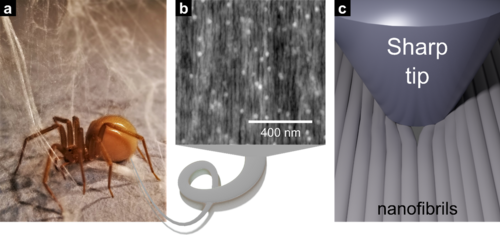Press Release: Nanofibrillar Structure of Recluse Silk
| July 10, 2022 — By Ben Skopic |
« prev | All Stories | next » |
Splitting Single Fibers of a Recluse Spider’s Web: Thousands of Fibrils Inside

Researchers revealed the inner make-up of a single fiber of the web of a brown recluse spider. These fibers are one hundred times thinner than a human hair. Never¬theless, each one is built like a cable, with thousands of thinner threads inside — rather than being made of a single piece.
The silk fibers of the spider web are as strong as steel, yet five times lighter. Scientists and laymen alike have wondered for decades what makes this material so amazingly strong. Dinidu Perera and his colleagues now got one step closer to a better understanding. Using electron and atomic force microscopes they found that the entire fiber is made up of about 2,500 nanofibrils, each 10,000 times thinner than a human hair. They then used extremely sharp silicon needles to pierce a single spider silk fiber. They found that the nanofibrils inside a silk fiber come apart relatively easily, which made it surprisingly easy to penetrate the fiber. Measuring the small pe-netration force precisely, the researchers were able to determine the sticking force between nano¬fibrils for the first time. Although the cable-like silk is as strong as steel, the individual fibrils inside do not stick together more strongly than sticky tape. This means that the fibrils can slide past each other when the silk fiber bends or make turns, and prevent un¬necessary fiber damage.
The detailed understanding of this wonder material newly developed by the team around Hannes Schniepp at William & Mary will help ongoing efforts to make synthetic spider silk. The needle method they invent¬ted has the potential for early diagnostics of cancers or osteo-arthritis. The story just appeared in Small, a well-known journal for nanoscale materials research.
Link: Publication.
Media Coverage of This Work
On TV, Video, and Radio Interviews
| Jul 2022 | Reporter and news anchor Anthony Sabella from channel 3 WTKR came to the lab to interview Dinidu Perera and Ben Skopic and learn more about our spiders. You can watch the video feature on our blog or the WTKR website! | |
Online Media
| Sep 2022 | William & Mary's student newspaper, The Flat Hat wrote a nice piece paper titled, “Biomaterials lab pioneers study of spider silk applications, publishes three groundbreaking papers”. You can view the article on the Flat Hat's website Here. | |
| Jul 2022 | Channel 3 WTKR wrote the story, "This spider's bite is dangerous, but local scientists say studying its steely silk could save lives" associated with the video interview. | |

